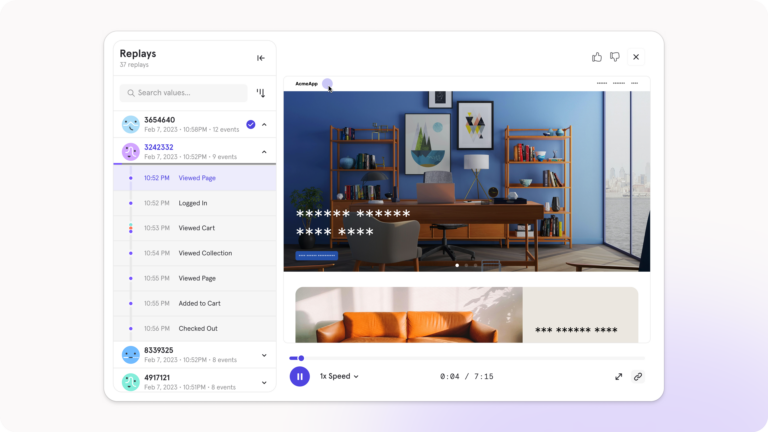
8 product analytics examples

Product analytics uses product and user behavior data to optimize or iterate on digital product’s design and function. Product analytics platforms track and help analyze this data for trends. Examples of product analytics include analyzing user conversion, activation, and churn data with the intention of improving those metrics.
All digital companies have data. Unfortunately, too many companies are not getting enough out of that data.
That’s because most apps and websites aren’t designed to run detailed reports on themselves. Without analytics, the user behavior data that could be chronicling how a product is or isn’t working is often inconsistently gathered and/or improperly formatted. Product analytics platforms make that data useful again by integrating all data sources into one single organized view to make it possible to uncover not only how a product is being used but why.
Companies use those insights to improve the product and create more value for users.
At the highest level, product analytics gives digital companies the information they need to increase revenue and drive growth.
What is product analytics?
Product analytics shows companies what their users really do, not just what they say they do. These are known as revealed behaviors, and they’re highly telling. Users aren’t very adept at predicting their own futures (consider any given New Year’s resolution) and having analytics allows product teams to dig deeper than human-error-prone surveys and user interviews. Hyper-detailed data leads to better product design and iteration decisions.
With product analytics, unique actions (called events) that users take within a product are tracked. Product managers, engineers, designers, and other digital builders then use the insights derived from that product usage data and analysis to improve retention, segment the most profitable users and offer them more value, uncover friction points within the product, improve user flows, and more
Product analytics examples
All of that is great in theory. But what does using product analytics look like in practice?
Here are a few real-world examples of how our customers have used the product insights they gained from Mixpanel to help them launch new products and features, grow their market share, and even determine product-market fit.
Product launch analytics examples
Product launches are tricky, high-stakes moments for any business. Measuring success or failure starts with finding the right product launch metrics to track—you want to be SMART and use metrics that are Specific, Measurable, Actionable, Realistic, and Timely. Most importantly, you want to make sure your team is aligned and working towards the same goals. Using product launch analytics will help you do that.
- Using product analytics to define better launch success metrics
LG CNS Haruzogak was having trouble with new product launches: They focused their resources on user acquisition, but they weren’t retaining those customers.
Instead of putting all of their efforts into user acquisition, they reframed their process on user activation and optimized their product to help users reach their ”aha” moment faster. With Mixpanel, they were able to gather quantitative insights that helped reshape their product launch process—and their company culture as a whole. User activation went up 11%, and employees have embraced a growth mindset, using data to champion their ideas and projects.
- Using product analytics to prepare for a launch
Before Golfshot released Auto Shot, they trained a machine learning model to recognize various golf swings and movements, including hitting a ball, not hitting a ball, and jogging out to the ball. They used Mixpanel to record the events from the Apple Watch and iPhone.
They used that data to determine when the product was ready to go to market and begin promotion—and after the launch, they continued to use Mixpanel to track the growth of adoption rate and utilization rate.
Product growth analytics examples
Identifying and tracking product growth metrics is the key to long-term success for your business—they can help you understand what’s working and spot moments of friction early before they cause major dropoffs or revenue losses down the line.
Here are a few examples:
- Using product analytics to support a product-led growth strategy
When AB Tasty adopted a product-led growth strategy, the company needed a solution to help them quickly see points of friction in their product and track product utilization. They were able to use Mixpanel insights to significantly improve their product tour completion rates and reduced the number of users skipping the product tour by 40%.
- Using product analytics to power growth from Day 0
Lemonade was a new player in an old industry: Before the company’s arrival, insurance had hardly seen any major changes or disruption in the last 150 years. To set themselves apart, the Lemonade team adopted a data-informed, customer-centric growth strategy, using Mixpanel to track events and gather insights from inception.
The strategy paid off. In just one year, Lemonade secured over 70,000 insurance policies for more than 100,000 policyholders, and those numbers are growing rapidly.
- Using product analytics to move from “hunches” to data
As the only music streaming platform dedicated exclusively to classical music, Primephonic built their Minimum Viable Product (MVP) based on their intuition and market research. But even as subscribers were increasing, app downloads were going down.
With Mixpanel, they were able to analyze their signup flow and discover a surprisingly low completion rate. They dug into the funnel steps and realized that their web-based registration process was causing friction. By fixing the issue and optimizing the flow, they were ultimately able to reach an 80% completion rate.
Product-market fit analytics examples
Even the scrappiest startup will fail if there’s no need for their product. That’s why product-market fit is crucial to all companies—especially early-stage startups. If they aren’t delivering value, they won’t survive. Fortunately, data can help.
- Finding the right overseas market
Talent matching platform CakeResume uses Mixpanel to track events, which helps the customer reduce user churn and optimize the user journey. When the product team looked at conversions, they realized that Indonesian users had particularly high conversion rates compared to other overseas markets. The company was able to use that data to focus more resources on Indonesia and grow market share there.
- Determining fit in a highly competitive market
When Passion Factory launched their chatbot-fueled fitness app, they knew entering the extremely competitive Korean health and fitness market would be challenging. They used Mixpanel to gather data and determine whether there was a need in the market for the chatbot health companion they wanted to build.
Mixpanel helped them track dropoffs with funnel reports and create more personalized dialogue options where necessary. With Mixpanel’s retention report, they were able to validate product-market fit and track consistent growth in user retention.
- Doubling marketing ROI with better product-market fit
As a learning platform operating across seven European countries, Evulpo serves students and teachers across many different markets.
With insights from Mixpanel, they realized that their offer had better product-market fit in the German-speaking part of Switzerland than in the French-speaking region. They used that information to optimize their marketing efforts, refocus their digital campaigns, and ultimately double their marketing ROI.
Product analytics = company analytics
These examples illustrate how product analytics can help power decision-making and steer company strategy. But your data is most powerful when it’s fully connected, from pre-signup all the way to revenue.
That’s why Mixpanel has added marketing analytics and Warehouse Connectors. Now, marketing data, product data, and business outcomes data are all unified and accessible to everyone, helping entire companies work together in alignment toward shared goals.
Get fast access to product, marketing, and company revenue insights for your whole team with Mixpanel’s powerful, self-serve analytics. Try it for free.






